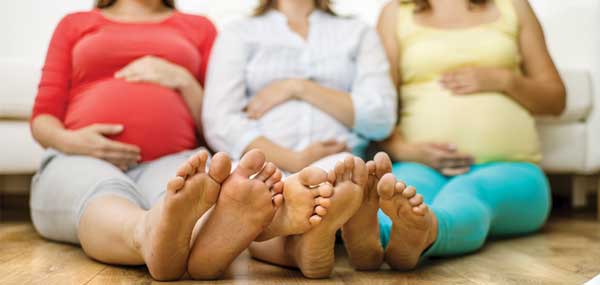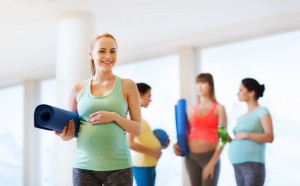Foot Pain During Pregnancy
During pregnancy, women can suffer from foot pain for various reasons. The most common which occur include general foot pain, plantar fascia pain, ingrown toe nails, corns and callous. These usually occur around the 2nd or 3rd trimester. This article discusses some of these problems, with some helpful tips to reduce any discomfort.

What causes foot pain during pregnancy?
Ligament laxity – During pregnancy there is an increase in the hormone relaxin. As the name suggests, relaxin causes relaxation of muscle and ligaments around the hip and pelvis to prepare for child birth. Although, it doesn’t only effect the hip and pelvis, but also other structures around the body including the feet. This ligament laxity can cause changes in the feet, particularly the arches. These changes may lead to increased load through certain muscles, joints and ligaments causing pain.
Increased fluid retention – While pregnant, there is an increase in the amount of blood and fluids produced by the body to cater for the baby’s needs. For this reason, women tend to experience fluid retention in their feet and ankles, manifesting in swelling. This can lead to increased pressure from tight fitting footwear, and problems associated with oedema.
Increased weight – With pregnancy comes weight gain, and as a result, increased loading through the feet and lower limb.
How to minimise pain during pregnancy
Footwear – Having the correct footwear can assist in the reduction of foot pain in a number of ways. Footwear should firstly have a method of loosening or tightening the shoes. This should ideally be laces, otherwise Velcro and buckle straps are okay. This decreases clawing of your toes and allows for loosening of the shoes as fluid retention increases. High heels should be avoided as they place greater strain on the forefoot, and are generally unstable. Shoes with a pointed toe should also not be worn as they increase the chance of ingrown toenails and corns. The ideal shoe during pregnancy is an athletic shoe, although this is not always appropriate.
 Exercise – More so during the end of the 2nd trimester and during the 3rd trimester largely weight bearing activities may need to be reduced or avoided. Activities such as swimming and pilates may be suitable. Swimming is a good option as it is non-weight bearing and can also act to reduce fluid retention. Pilates instructed by a qualified physiotherapist can be a good way to strengthen muscles around the pelvic girdle, which can reduce pelvic instability. Always consult with your obstetrician regarding your exercise routine.
Exercise – More so during the end of the 2nd trimester and during the 3rd trimester largely weight bearing activities may need to be reduced or avoided. Activities such as swimming and pilates may be suitable. Swimming is a good option as it is non-weight bearing and can also act to reduce fluid retention. Pilates instructed by a qualified physiotherapist can be a good way to strengthen muscles around the pelvic girdle, which can reduce pelvic instability. Always consult with your obstetrician regarding your exercise routine.
Minimising fluid retention – Legs should be elevated at the end of the day, and also after long periods of being on your feet. Calf and foot exercises can be effective in reducing fluid retention in the calf, ankles and feet, as well as the exercises mentioned above, supportive socks and stockings can also assist in this matter, although a GP should be consulted prior to purchasing these.
For further help and advice on foot care during pregnancy, please make an appointment to see one of the podiatrists at Burleigh or Runaway Bay clinic ph 07 5500 6470
Nelson Pollard
PODIATRIST
Gold Coast Foot Centres
